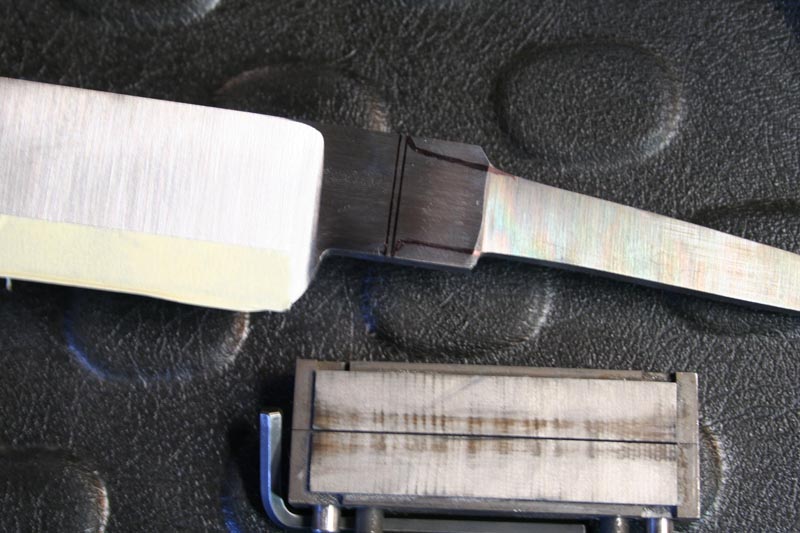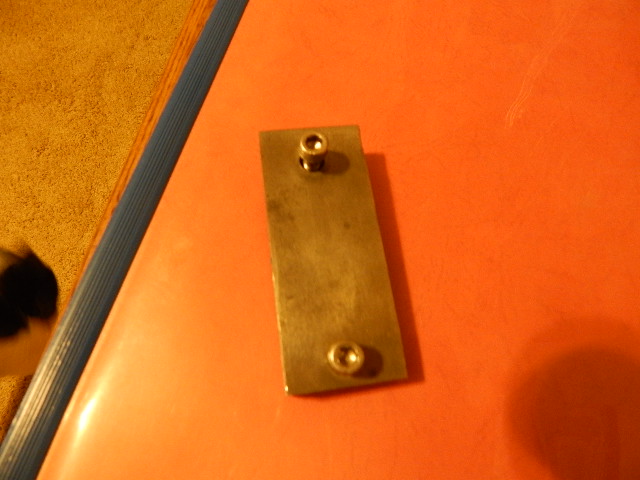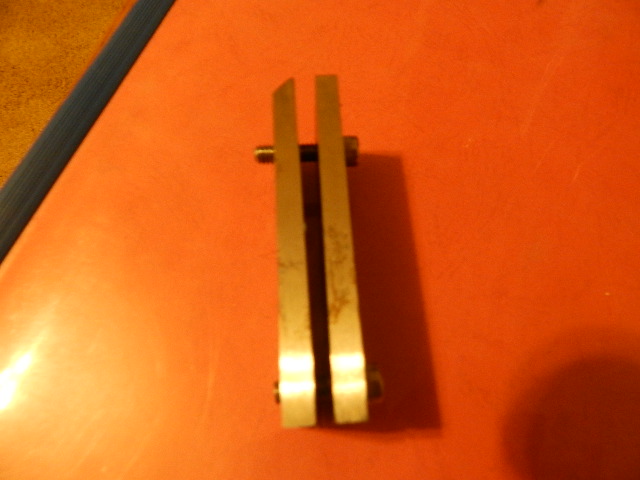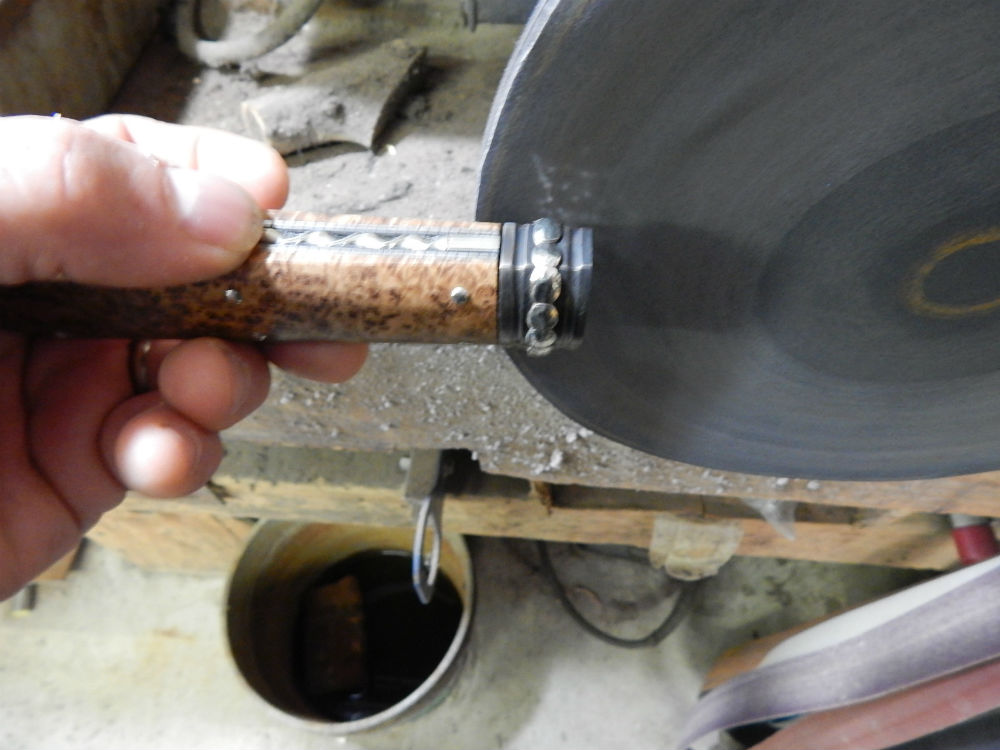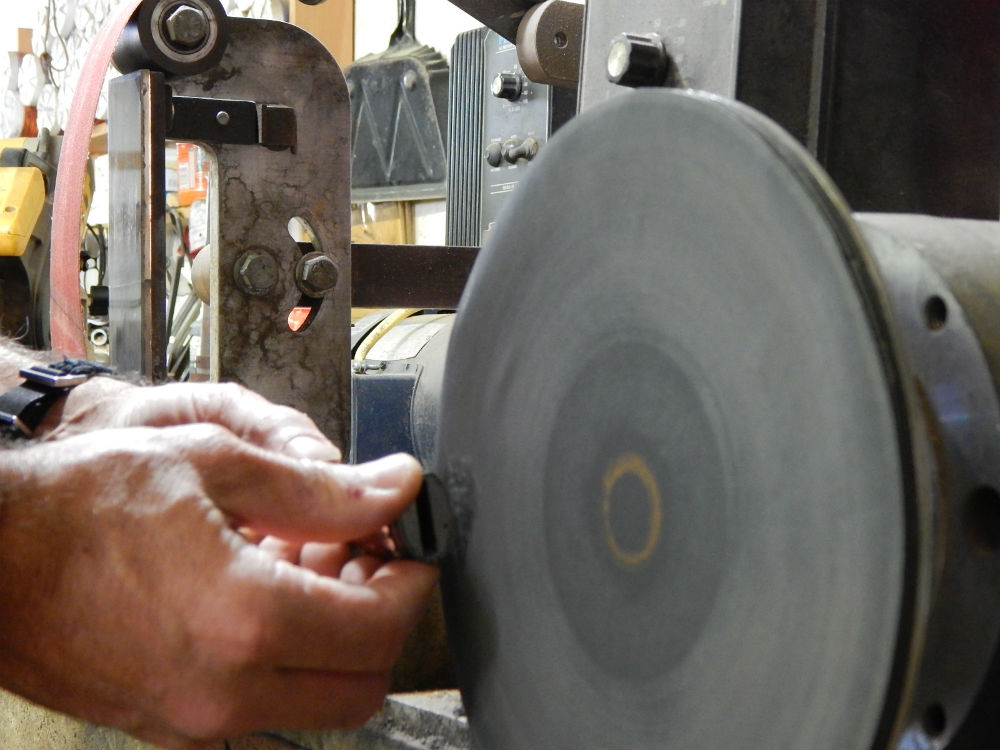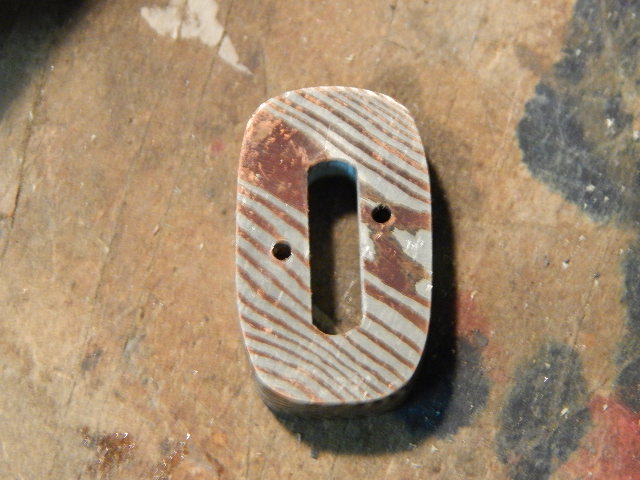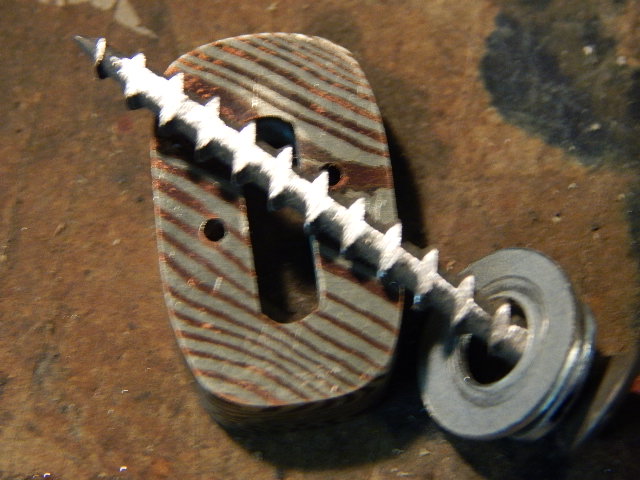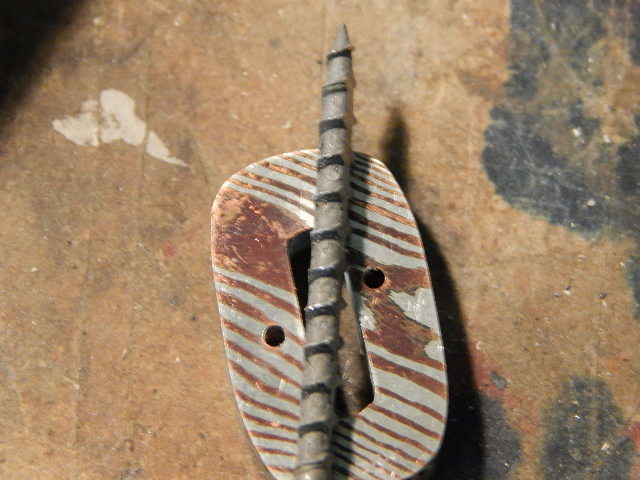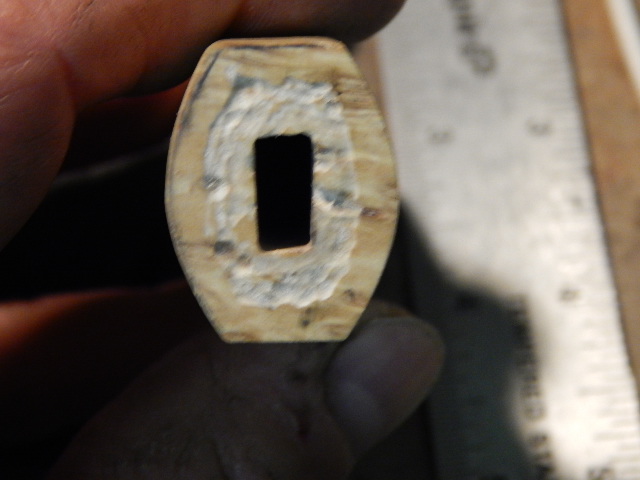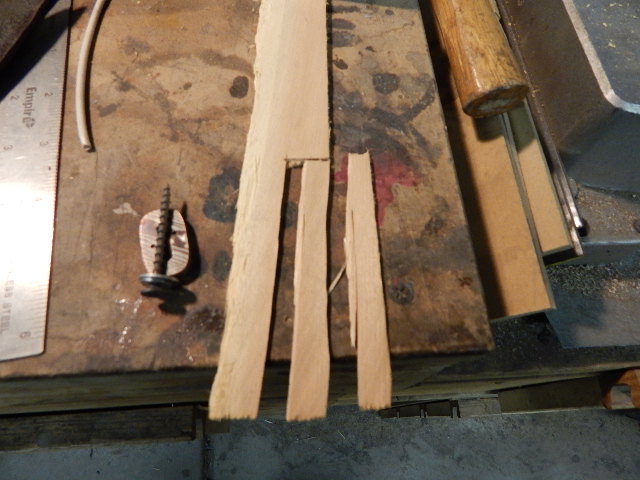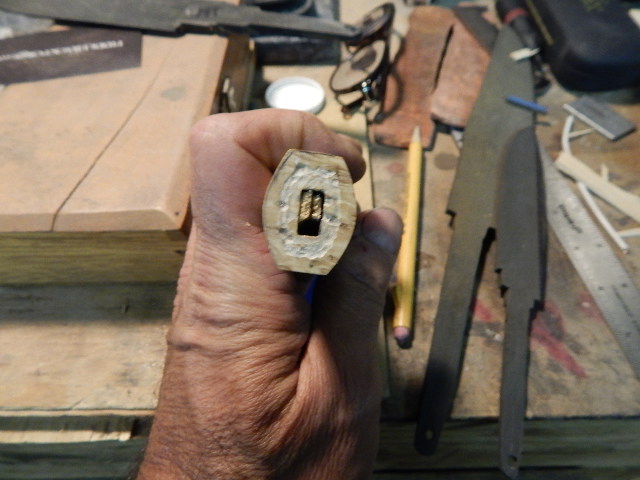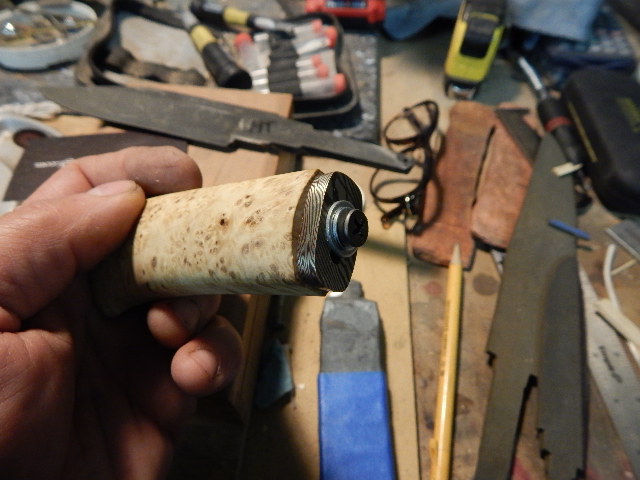I know the majority of us do hidden tangs, For the newcomers here this months topic will be the basics of guard fit up to your blade. What tools and jigs do we use? What materials are preferred? What about odd shaped guards with curves or d guards? How do you attach the guard? And what about multi piece guards? I realize this covers a lot of territory, but for people just starting out it is good reference material. Plus some of us old guys may learn some new things too. Also I apologize for being late with this one. I just got back from a class today. I look forward to seeing the replies. And new members, if you have questions about this subject ask away. We will try to help.
Brion
Brion Tomberlin
Anvil Top Custom Knives
ABS Mastersmith
If a person can sit through my first two or three videos on a knife build, I go through a live-time knife assembly showing guard fit in detail:
[media] http://www.youtube.c...HqlKL8tzbc&t=5s [/media]
[media] http://www.youtube.c...h?v=Qs03vngAlBU [/media]
Karl B. Andersen
Journeyman Smith
Thank you Karl!
Brion
Brion Tomberlin
Anvil Top Custom Knives
ABS Mastersmith
What tools and jigs do we use?
I would say that one of the most important tools is a GOOD, CARBIDE file guide. These tools are certainly not cheap, but a well made one is worth it's weight in gold!
What materials are preferred?
This is something that I feel far too many overlook. It's not just about what will "look good", it's also about what material will work best for the given situation. In general, Nickel Silver and brass are the easiest guard materials to get good fits with. The vast majority of my guards are "press fit", and using a material that is softer then a blade's tang is critical to achieving that tight fit. When it comes to a "press fit", materials that are softer then a blade's tang allow the guard material to slightly deform, conforming itself to every slight variation of the tang/guard juncture. Both of these materials have a little more "spring" than other materials....this means I can press fit the guard, then "pop" it back off, for final finishing, and then it will require being "pressed" back into place.
How do you attach the guard?
For me, nothing more than the pressure of the "press fit"..... in my opinion if a person feels they must use solder (yuk), JB Weld, or any other "glue" to hold a guard in place....then your fit isn't tight enough.
Odd shaped and multi-piece guards present special circumstances to the knifemaker, and there is no "one size fits all" when it comes to fitting/placing these types of guards. Many of the same principles apply, but there are often extra steps, or modified techniques to get these same "seamless" fits as "standard" or "simple" guards.
Most Bladesmiths/Knifemakers develop their own techniques over the years, but for me, it all begins at the forge. I often hear/read about how the ricasso area(s) on a blade "must be flat and parallel. I simply do not subscribe to that. I forge in a distal taper in nearly all blades, which makes the end products look like an elongated diamond when looking down at the spine. The thickest part of the blade is at the middle of the ricasso.... tapering from there rearward, and again forward to the blade's tip. This aids greatly in a tight fitting guard.... the tang. When I cut the "slot" in guard material, it is a tapered hole, with the smallest being the front of the guard, and the larger end of the opening facing the handle material. As the guard is pressed into place, it has not choice but to get tighter and tighter. The entire technique is explained in a video available at: http://www.legacystudioproductions.net/knifemakertraining/
Ed Caffrey, ABS MS
"The Montana Bladesmith"
www.CaffreyKnives.net
I fit my guards pretty well as Brion and Ed has described. Maybe a mix with a little of my own preferences. The file guide is a fine tool if well made and well cared for. I also use a very strong guard press to seek the tightest fit within reason to insure that it is a mechanical fit, not relying on glue or sealant except for just that, a sealant.
In my opinion, tight joints on a hidden tang knife, are the real strength of the knife. There is an argument by , in my opinion, often made by inexperienced makers and buyers, that a full tang knife is stronger than a hidden tang. I don't agree with that. I do concede that a full tang BLADE is likely stronger in a side by side flex/bend test. However after adding the handle components properly and with tight joints, I see the possibility of the hidden tange being actually stronger as a complete knife depending on materials. That a hidden tang knife is strong has been proven time and again in Master Smith Performance Tests, the knives being hidden tang as required by the rules of testing. A lot of knives used by makers in cutting competitions are hidden tang also lending evidence that they are strong and tough. The fact that some of these proven and tested knives are take down in construction means that hidden tang knives, when well fit and using suitable materials, proves where the real strength lies. Tight joints. Mastery over the tools and techniques used to achieve tight joinery will take the knife maker from a beginner to a skilled knife maker.
|quoted:
I see the possibility of the hidden tange being actually stronger as a complete knife depending on materials. That a hidden tang knife is strong has been proven time and again in Master Smith Performance Tests, the knives being hidden tang as required by the rules of testing.
My JS test knife was a hidden tang - and take-down as well. I just about pulled Don Hanson's vise off the wall getting to 90* and needed a cheater pipe to make that happen.
If you need a knife stronger than a properly built hidden tang - then you need something other than a knife.
Karl B. Andersen
Journeyman Smith
For those folks who do not have the $150 or so that a good carbide file jig costs and want to make something that comes close, (but needs maintenance) I made this one from two pieces of O-1. Hardened and tempered at 250*.
The pieces were 1/4" precision ground flat stock. I super glued them together with the edges lined up and drilled the holes straight through both pieces. Then I took them apart, over-bored the holes in one of them and tapped the other side's hole to fit a 1/4-20 caphead screw. Them I heat treated the two of them, put them together with the screws and surfaced one edge. I still use this tool when laying out and doing some file work. It will definitely work for setting the shoulders with a file or a disc grinder, but don't press too hard or you will sand down into the O-1 and have to resurface the edges.
Joshua States
www.dosgatosforge.com
https://www.youtube.com/channel/UCdJMFMqnbLYqv965xd64vYg
https://www.facebook.com/dos.gatos.71
Also on Instagram and Facebook as J.States Bladesmith
“So I'm lightin' out for the territory, ahead of the scared and the weak and the mean spirited, because Aunt Sally is fixin’ to adopt me and civilize me, and I can't stand it. I've been there before.â€
|quoted:
What tools and jigs do we use? What materials are preferred? What about odd shaped guards with curves or d guards?
Brion
Most of my tools and jigs are shown in the September 2016 topic of the month, but I did want to talk a little about those curved guards and oddly shaped ones. I fit all of my guards to the tang while the guard material is flat and fairly or totally rough. I do most of my shaping after the slot is cut and the guard is press fit to the tang. I have not forged guards to shape as some of the other smiths do, so I would appreciate some of them discussing their methods. For my simple curved or S guards, the curves are done after the fit up is complete.
Joshua States
www.dosgatosforge.com
https://www.youtube.com/channel/UCdJMFMqnbLYqv965xd64vYg
https://www.facebook.com/dos.gatos.71
Also on Instagram and Facebook as J.States Bladesmith
“So I'm lightin' out for the territory, ahead of the scared and the weak and the mean spirited, because Aunt Sally is fixin’ to adopt me and civilize me, and I can't stand it. I've been there before.â€
I don't have much to add as I learned to fit my guards mostly from Karl. One thing though that I didn't see mentioned is when a shoulder is not cut all the way around the tang (which I think creates a weak point) the fit has to be that much better.
To close a gap on a guard where I may have gotten a little more off than I wanted with a file I will peen the inside edge of the guard slot and the grind the high points down (the whole rest of the guard face) to the bottom of the divit.
You can see an example of this in this video https://m.youtube.com/watch?v=2A0NZU29S_0
I've started punching and using the tang to drift till about 3/16 from the shoulder and then file to fit.
This has saved me some time.
What I have to make sure is square the part on the grinder after punching and drifting.
I do this by making sure my work rest is at 90 degrees to the platen with an angle finder.
Then I lay the part shoulder side down and grind one side flat.
Take the flat side and put it on the work rest and grind the shoulder side of the guard flat then the handle side flat.
Then I grind the other side flat and check the part for squareness with a micrometer.
To make sure I'm square, if its out, I will use the micrometer to scribe the lowest point on the part minus a few thousandths all the way around the part on the handle side.
Then I will grind it flat.
I file to fit and use a pipe to drive the part on.
I have had no luck with with guard Jacks/guard press.
Mine do not stay on the tang.
Any suggestions here I would love.
My biggest trouble.
The biggest sticking point for me is when I make the handle and guard flush I inevitably grind away handle material faster than metal.
Drives me crazy and I have to watch out for it because it happens all the time.
|quoted:
My biggest trouble.
The biggest sticking point for me is when I make the handle and guard flush I inevitably grind away handle material faster than metal.
Drives me crazy and I have to watch out for it because it happens all the time.
Two questions to answer:
Are you grinding on the belt or disc? Is the handle on the blade or off the blade?
Very few of my knives have the handle on the blade when I finish them. I typically will assemble handle and spacer package with blind pins and hold it together with either a threaded rod and nut (through tangs) or a drywall screw (hidden tangs). I show a system for keeping symmetry in the Seax WIP thread: My link and work it mostly on the disc at about 50% speed.
These photos show placement and handling on the disc. I just work the front portion on the edge area of the disc.
Once I have the spacer and handle flush I add the guard and scribe where I want to get to. Remove the guard and grind it down to the scribe line on the belt with the table squared. Then I add the guard to the blade and seat the handle and spacer package. Flush the guard to the handle (spacer or no spacer) with a fine (#4) file and sand to finish off the knife and handle.
If you want to grind the guard at the same time as the handle (with or without a spacer) and off the knife, hold the guard to the handle with blind pins and a drywall screw. You may have to grind off two sides of the screw teeth to fit it through the slot in the guard/spacer. A 1/4 turn of the screw will hold everything nice and tight. Grind as above on the disc.
The other method is to shape everything on the knife blade with files and rasps. A using the metal piece (guard) as a guide and a gentle touch will keep you from digging into the handle material.
If anyone wants some photos, I will try and take some to show how this works. Just let me know.
Joshua States
www.dosgatosforge.com
https://www.youtube.com/channel/UCdJMFMqnbLYqv965xd64vYg
https://www.facebook.com/dos.gatos.71
Also on Instagram and Facebook as J.States Bladesmith
“So I'm lightin' out for the territory, ahead of the scared and the weak and the mean spirited, because Aunt Sally is fixin’ to adopt me and civilize me, and I can't stand it. I've been there before.â€
I grind on a belt sander.
Can you post pics of how you use dry wall screws?
The challenge for me with working the handle, guard and spacer off the blade is really rue measurements on top, bottom and sides.
If the guard is on the handle and I am trying to grind the finger well on the lugs, how is that done on the disc?
I can do it on a small wheel attachment.
Which I have been doing.
I leave it over sized.
Then remove the guard and finish grinding to size.
Then I have a choice.
I can leave the handle slightly larger and radius its edges in a make a "Heirloom" fit.
Or I can put it back on and file it to fit or try to sand it on the belt sander with high grit belt and a slack belt.
The file works, is slow and then sanding out the file marks takes a lot of time.
Of course there is more danger in using the power tools.
If anyone can show how they actually lay out alignment pins that would be awesome.
In contrast to the top and bottom of the ricasso.
JJ, lots of questions there so I will try and answer them one by one starting with the first and the last ones together. Most of these are going to show how I do the handle off the knife with the spacer package attached. You can add the guard, but with a single or double branch guard, it becomes an equipment change to get the finger lug (as you call it) and the top of the guard (on a double branch). These I will address later. but I typically do those guards not flush with the handle or only flush on the sides anyway, so the branch areas are done with hand tools. The pictures I am going to use do not show an actual knife in process, but I dug around the scrap pots for a handle and spacer that I could demonstrate with.
My alignment pins are laid out in relation to the tang, and I purposely offset them in relation to both center lines so that there is only one way to assemble the spacer to the handle once it is made. (pretend this spacer is not shaped yet)
Now, the drywall (DW) screw will not fit through that slot. So, you have to grind off the teeth on opposite sides of the screw to make it thin enough to pass through the slot.
Hopefully, your slot in the handle is not much wider than the slot in the spacer, but if it is (like this one) you will need some wood shim material.
I use thin pieces of cedar shims from Home Depot.
Slide them down the handle slot (fat end first) and break them off. They should be loose in the hole, but wide enough to overlap center.
Now put your spacers or spacers & guard in place using the alignment pins.
Slip a couple of washers over the screw, (put a leather one against the guard face so not to scratch it up), slip the screw through the slot and in between the wood shims. Tap it down until it is tight against the face and give it a 1/4 turn. It will hold everything together tightly.
Joshua States
www.dosgatosforge.com
https://www.youtube.com/channel/UCdJMFMqnbLYqv965xd64vYg
https://www.facebook.com/dos.gatos.71
Also on Instagram and Facebook as J.States Bladesmith
“So I'm lightin' out for the territory, ahead of the scared and the weak and the mean spirited, because Aunt Sally is fixin’ to adopt me and civilize me, and I can't stand it. I've been there before.â€

